
How to Handle Conflict in the Workplace: 10 Strategies That Work
Disagreements are a natural part of working with others, but when workplace conflict remains unresolved, it can seriously hurt productivity.
Whether it’s a clash of personalities, unclear expectations, or lingering frustration after a stressful project, conflict is bound to arise in any team setting.
According to the Workplace Peace Institute’s April 2024 survey, conflict is widespread across all organizational levels.
Most notably, 32% of conflicts occur between management levels, while 22% happen between line managers and their direct reports, and 20% among senior executives.
The toll isn’t just relational—it’s costly. 88% of employees have seen poor morale, and over half reported stress, bullying, or personal attacks.
Alarmingly, 23% left their jobs, and 77% of the workforce is disengaged due to unresolved issues.
That’s why understanding how to resolve conflict in the workplace is a skill every leader, manager, and team member needs.
It’s about using emotional intelligence, creating psychological safety, and setting up clear processes so issues don’t spiral out of control.
In this article, we’ll explore the types and causes of workplace conflict, common examples (from passive-aggressive behavior to performance review disputes), and proven strategies to handle them.
You’ll also learn effective conflict resolution strategies for both managers and team members, and understand how HR professionals can leverage tools like anonymous feedback and mediation to provide vital support.
What Is Workplace Conflict and Why Does It Happen?
Workplace conflict refers to any disagreement or tension between individuals or groups at work. It can arise from a variety of sources, including miscommunication, personality differences, power struggles, or even organizational structure.
While some level of conflict is normal and even healthy for growth, unmanaged conflict can lead to employee anger, disengagement, stress, and team dysfunction.
Understanding the root causes of conflict helps teams respond faster and more effectively.
When workplace conflict resolution strategies are in place, organizations can prevent disputes from escalating and protect both productivity and morale.
The Crucial Role of Conflict Resolution in the Workplace
Conflict is part of any workplace—but the longer it’s ignored, the worse it gets. Knowing how to handle conflict in the workplace early on isn’t just a soft skill—it’s a business necessity.
Timely intervention helps keep teams focused, relationships healthy, and operations running smoothly. Here’s why early action matters:
- Prevents Resentment and Escalation
Unresolved issues often linger beneath the surface, leading to long-term grudges, team cliques, or even open hostility. What begins as a simple disagreement can evolve into a full-blown conflict if not addressed. Effective workplace conflict management stops this cycle early, preventing lasting damage to team unity.
- Maintains Daily Productivity
Tension among team members distracts everyone involved. Conflicts lead to missed deadlines, delayed decisions, and disengaged employees. By resolving disputes quickly, leaders help their teams refocus and maintain performance standards.
- Preserves Trust and Psychological Safety
Employees are more likely to speak up and raise concerns when they know someone will listen. Early intervention sends the message that professional conduct matters and that management values emotional intelligence and respectful disagreement. This builds psychological safety and manager-employee trust.
- Reduces Risk of Talent Loss and Burnout
Talented employees often leave toxic environments, not companies. When conflict goes unmanaged, top performers may walk away—and those who stay may face emotional exhaustion. Dealing with issues early helps retain strong talent and prevent workplace burnout.
- Minimizes Legal or HR Escalations
The longer a dispute drags on, the greater the risk of formal HR involvement, legal claims, or reputational damage. Using tools like workplace mediation or conflict resolution training programs early can prevent issues from escalating into more serious employee relations problems.
Acting early isn’t just the right thing to do—it’s smart, strategic leadership.
Causes of Conflict at Work
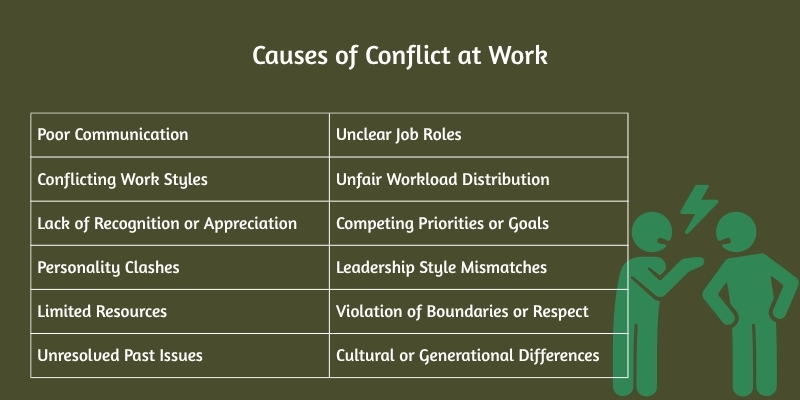
Below are the most common reasons conflict arises on the job:
- Poor Communication: Misunderstandings often happen when there’s a lack of clarity around expectations, feedback, or daily tasks. Office disagreements often begin when messages are vague or incomplete, especially in remote teams where tone is easily misread.
- Unclear Job Roles: When employees aren’t sure who’s responsible for what, tasks can get duplicated or dropped altogether. This confusion can spark frustration and interpersonal conflict at work.
- Conflicting Work Styles: Some people thrive with collaboration, while others prefer independence. Differing approaches to problem-solving, deadlines, or organization can quickly lead to tension among coworkers.
- Unfair Workload Distribution: If some team members feel like they’re doing more than others, or if there’s visible favoritism, resentment builds. This is one of the most common workplace arguments teams face.
- Lack of Recognition or Appreciation: Failing to acknowledge someone’s efforts can feel like a personal slight. Over time, this can damage employee morale and trust in leadership
- Competing Priorities or Goals: Departments or team members might be aligned with different targets. Without proper communication and alignment, their goals can clash, ultimately leading to conflict escalation.
- Personality Clashes: Not everyone gets along. Differences in values, emotional intelligence, or even social styles can lead to tension, especially under pressure or during team collaboration challenges.
- Leadership Style Mismatches: A manager who micromanages or imposes a top-down approach may clash with teams that value autonomy and trust. This mismatch can weaken manager-employee trust and create psychological safety issues.
- Limited Resources: When there aren’t enough staff, tools, or budget to go around, departments may compete with each other. This competition often fuels team tension and stress at work.
- Violation of Boundaries or Respect: Crossing personal or professional boundaries—whether through rude comments, exclusion, or microaggressions—can quickly turn into serious disputes. These issues often require HR intervention.
- Unresolved Past Issues: Old arguments don’t always stay buried. If past conflicts aren’t fully addressed, they may resurface and create new dysfunction in team dynamics.
- Cultural or Generational Differences: Workplaces are increasingly diverse, and differences in communication style, work ethic, or hierarchy expectations can create misunderstandings.
Recognizing and respecting these differences is key to healthy employee relations.
Types of Conflict in the Workplace
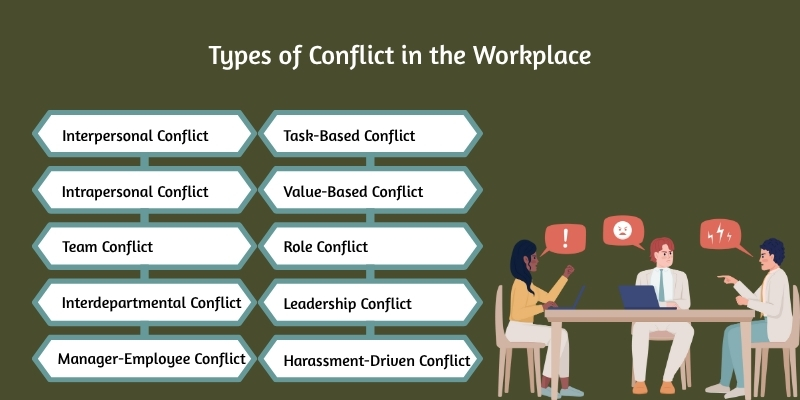
Workplace conflict can show up in many forms—some obvious, others more subtle. Recognizing the type of conflict helps HR managers, team leaders, and employees choose the best strategy for resolution.
Whether it’s a disagreement between coworkers or deeper team dysfunction, each conflict type demands a different approach, often blending emotional intelligence, clear performance feedback, and workplace conflict resolution strategies.
Here are the most common types of conflict found in professional settings:
- Interpersonal Conflict: This is the most visible type—tension between two employees caused by personality clashes, poor communication, or differing work habits. These disagreements can lead to passive-aggressive behavior, poor collaboration, and a toxic work environment if left unresolved.
- Intrapersonal Conflict: This occurs within an individual, often related to inner doubts, ethical concerns, or unclear job expectations. These internal struggles may result in stress at work, decreased morale, or disengagement—impacting both personal performance and team energy.
- Team Conflict: When groups disagree on direction, responsibilities, or contribution levels, team conflict arises. It’s often triggered by poor communication, unequal effort, or unclear goals, and can reduce overall productivity and psychological safety.
- Interdepartmental Conflict: Departments may clash over shared resources, project ownership, or strategic priorities. This type of conflict usually involves misaligned goals and broken cross-functional communication, requiring proactive leadership and sometimes HR documentation.
- Manager-Employee Conflict: Power dynamics, inconsistent feedback, or unclear expectations can create tension between supervisors and their teams. These conflicts affect trust, engagement and may require mediation or involvement from an Employee Assistance Program (EAP).
- Task-Based Conflict: Even well-meaning team members can disagree on how to complete a task. Disputes may arise around timelines, tools, or decision-making authority—especially in fast-paced, project-based environments.
- Value-Based Conflict: Clashes involving personal beliefs, ethics, or cultural perspectives fall under this category. In diverse workplaces, such disagreements can escalate quickly unless addressed with respect and inclusion strategies.
- Role Conflict: This happens when responsibilities overlap, or reporting lines are unclear—causing confusion, duplicated work, or resentment. It’s a common issue in growing teams and organizations lacking a clear Employee Code of Conduct.
- Leadership Conflict: Conflicts between managers or executives often stem from different leadership styles, strategic visions, or decision-making approaches. These disputes can affect organizational culture and require advanced conflict management skills.
- Discriminatory or Harassment-Driven Conflict: This includes any conflict rooted in bullying, discrimination, or harassment. Such serious issues need immediate HR or legal intervention and may also require workplace mediation services or formal employee relations procedures.
By identifying the type of conflict, employers can apply the right tools—from professional conduct guidelines to de-escalation techniques—to foster a respectful and high-performing work culture.
Signs of Conflict at Work
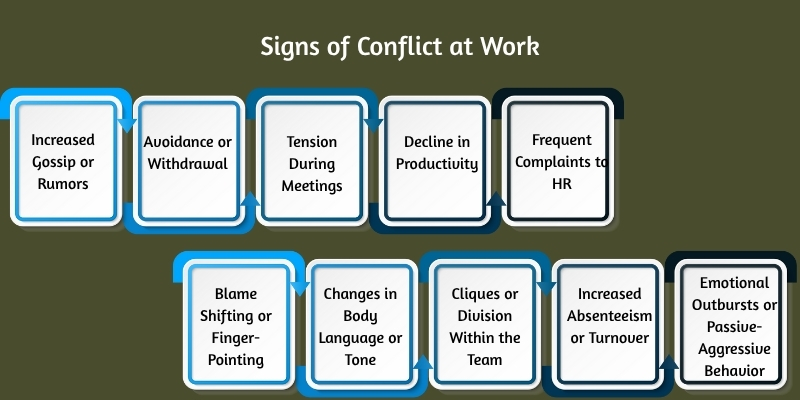
Conflict doesn’t always show up as shouting or arguments. More often, it bubbles beneath the surface—hidden in behaviors, tone, and team dynamics.
Recognizing early warning signs helps leaders and HR professionals take action to deal with anger at the workplace.
Whether you’re managing a team or part of one, here are key red flags that signal the need for workplace conflict resolution.
- Increased Gossip or Rumors: Instead of discussing concerns openly, employees begin whispering about coworkers or supervisors. Gossip is often a sign that psychological safety is lacking and that interpersonal conflict at work is being ignored.
- Avoidance or Withdrawal: When a team member starts to skip meetings, avoid group chats, or go silent around certain colleagues, it’s a sign of discomfort. Withdrawal can indicate unresolved tension or fear of confrontation—key challenges in managing team dysfunction.
- Tension During Meetings: Nonverbal cues like eye rolls, sarcasm, and frequent interruptions reveal more than words. These are early signs of conflict, especially when meetings become uncomfortable or unproductive.
- Decline in Productivity or Missed Deadlines: If team output drops or employees miss deadlines, it may be due to emotional distractions caused by internal disputes. Low morale often leads to disengagement and reduced focus.
- Frequent Complaints to HR or Management: Repeated concerns—even informal ones—signal that employees feel unheard. When feedback turns into constant grievance, HR intervention procedures may soon be necessary.
- Blame Shifting or Finger-Pointing: Accountability disappears when people are in conflict. If employees begin blaming each other for mistakes, it’s time for de-escalation techniques and constructive feedback strategies.
- Changes in Body Language or Tone: Crossed arms, raised voices, or cold tones often speak louder than words. Sudden changes in how someone communicates can reflect workplace hostility or emotional fatigue.
- Cliques or Division Within the Team: When teams form “sides” or isolate certain individuals, collaboration breaks down. These divisions often stem from unresolved conflicts and lead to lasting team tension.
- Increased Absenteeism or Turnover: Employees may avoid work altogether when it becomes emotionally draining. Rising absenteeism and voluntary turnover are common outcomes of unresolved workplace arguments and burnout.
- Emotional Outbursts or Passive-Aggressive Behavior: Explosive reactions or subtle digs (like sarcasm or backhanded compliments) usually signal frustration. Left unchecked, these behaviors can escalate into serious conflict, requiring workplace mediation services.
Understanding these signs empowers managers, team leads, and even coworkers to take action using conflict management in the workplace before the damage spreads.
Real-World Workplace Conflict Example
Conflict in the workplace isn’t just theory; it happens every day in real organizations. Real-life examples not only show how conflict can be managed but also highlight the cost of leaving it unresolved.
These scenarios demonstrate both successful resolution and painful consequences, offering valuable takeaways for improving conflict management in the workplace.
Case Study: Starbucks – Tension between Management & Employees
In early 2024, Starbucks faced escalating tensions between management and employees at several unionized locations.
Workers reported concerns over unfair scheduling, wage disparities, and alleged retaliation for union activities. Conflict arose at a Chicago branch, where employees staged a walkout over working conditions.
Resolution Strategy
HR and department heads introduced weekly alignment meetings between employees and management.
Starbucks’ HR department intervened by:
- Mediating Discussions: HR facilitated structured dialogues between employees and management to address grievances.
- Policy Adjustments: Revised scheduling practices and improved transparency in wage structures.
- Anti-Retaliation Measures: Implemented stricter policies to prevent retaliation against union supporters.
- Training Programs: Rolled out conflict resolution and diversity training for managers.
Outcome
The Chicago location saw improved employee morale, and similar HR-led interventions helped de-escalate tensions in other stores.
While union disputes continue at some branches, HR’s proactive approach was praised for reducing hostility and fostering better communication.
Key Takeaway
Proactive leadership and structured communication helped transform conflict into collaboration.
10 Proven Strategies for Handling, Managing, and Resolving Workplace Conflict
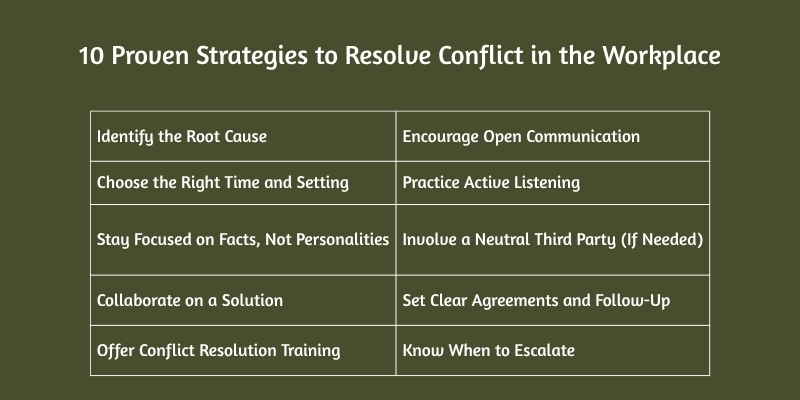
Effectively resolving workplace disputes requires more than just calming tempers—it involves structure, empathy, and proactive steps.
Whether you’re a team leader, HR manager, or employee, these workplace conflict resolution strategies will help create a healthier, more productive environment.
1. Identify the Root Cause
Look beyond surface tension and understand the deeper issue driving the conflict. Miscommunication, unclear expectations, or mismatched values are often at the core.
- Example: A team member missing deadlines may be unclear about their responsibilities—not lazy.
2. Encourage Open Communication
Create a space where employees feel safe expressing concerns without fear of backlash. Use neutral, respectful language and foster psychological safety to prevent team dysfunction.
- Example: Use “I feel” statements to avoid sounding accusatory.
3. Choose the Right Time and Setting
Timing and privacy matter. Address issues in a calm setting to avoid embarrassment or heightened emotions.
- Example: Don’t confront an employee minutes before a major presentation.
4. Practice Active Listening
Active listening promotes empathy and helps clarify misunderstandings. It also builds manager-employee trust and reduces the chance of misinterpreting intent.
- Example: “So you’re saying the new process feels unfair to your team?”
5. Stay Focused on Facts, Not Personalities
Frame the issue around behavior or outcomes, not personal traits. This encourages respectful disagreement and helps avoid triggering defensiveness.
- Example: “The task was completed 2 days late” vs. “You’re careless.”
6. Involve a Neutral Third Party (If Needed)
If emotions run high or biases exist, a neutral mediator or HR professional can provide structure and fairness. This aligns with dispute management best practices.
- Example: Use a facilitator when team trust is too low for direct resolution.
7. Collaborate on a Solution
Use collaborative problem-solving to give all parties a voice. This increases accountability and commitment to the outcome.
- Example: “What do you think would improve communication here?”
8. Set Clear Agreements and Follow-Up
Resolution doesn’t end with one conversation. Use HR documentation tools to record outcomes and set review dates to reinforce accountability.
- Example: “We’ll revisit progress in 2 weeks on Monday.”
9. Offer a Specialized Training Program
Invest in professional development through conflict resolution training programs, emotional intelligence workshops, or scenario-based learning.
These initiatives help employees manage tension calmly and constructively, especially in high-stress roles.
Incorporating anger management training for employees can be effective for teams, as individuals can learn to recognize triggers, manage reactions, and maintain professionalism during conflicts.
10. Know When to Escalate
Not all conflicts can be resolved informally. If the issue involves harassment, legal risk, or recurring behavior, escalate it through formal HR intervention procedures or legal channels.
- Example: Notify HR if a conflict violates company policy or endangers safety.
With the right tools and approach, you can turn conflict into an opportunity for growth, better communication, and stronger team collaboration.
Conclusion
Conflict is an inevitable part of working with people—but it doesn’t have to be destructive.
With the right mindset, tools, and communication strategies, organizations can transform tension into teamwork and disagreements into growth.
Whether it’s a clash of personalities, competing goals, or unclear expectations, learning how to resolve conflict in the workplace is essential for leaders, HR professionals, and team members alike.
By addressing issues early, focusing on root causes, and fostering open dialogue, teams can build trust, boost morale, and create a culture of psychological safety.
Remember, the goal isn’t to avoid conflict altogether – it’s to resolve it with empathy, clarity, and fairness so your workplace thrives.
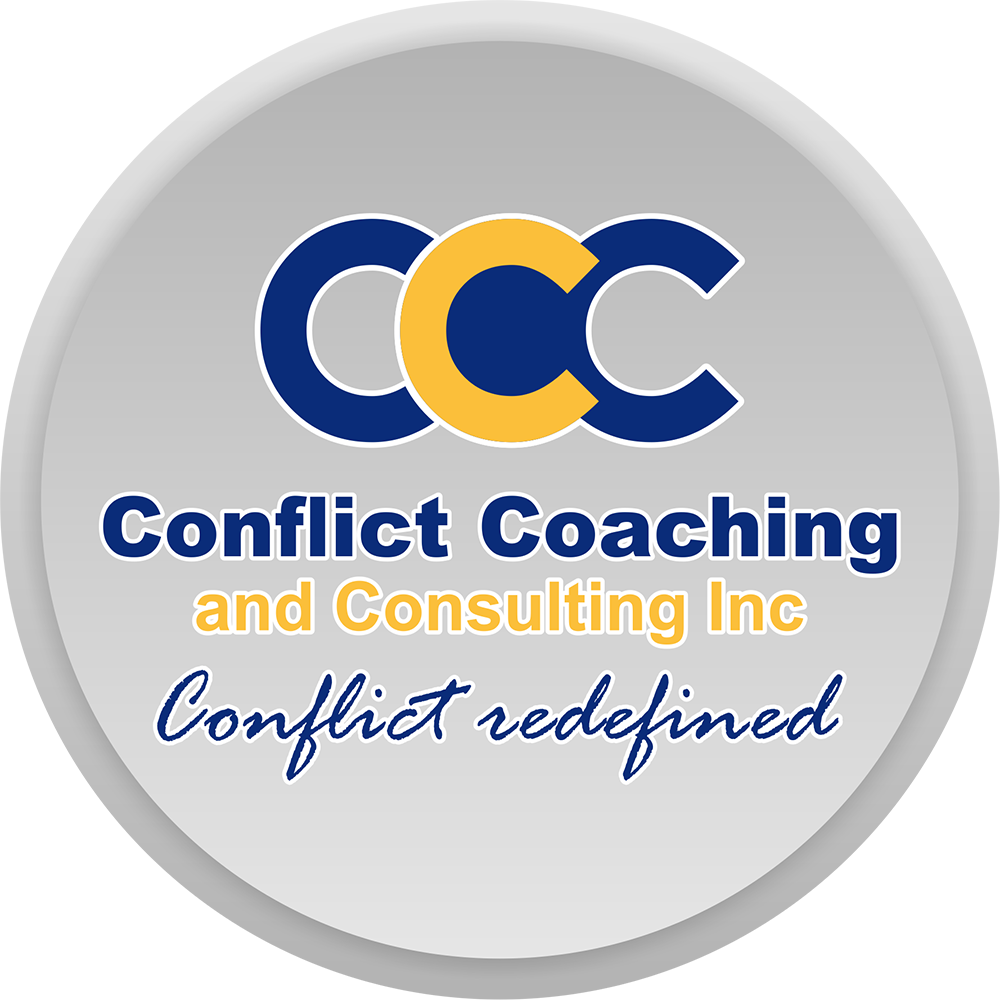




Responses